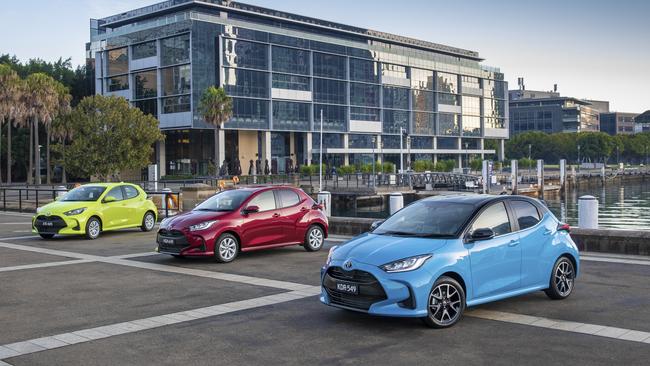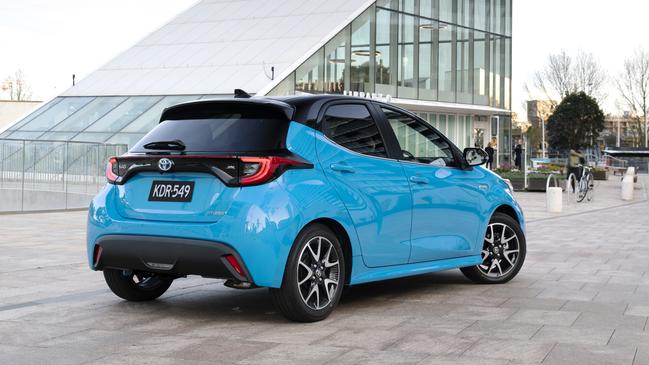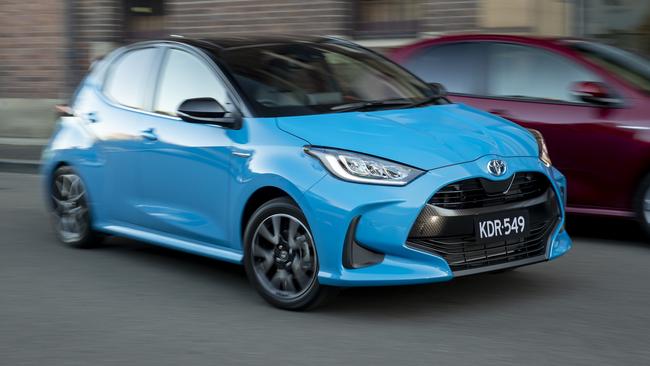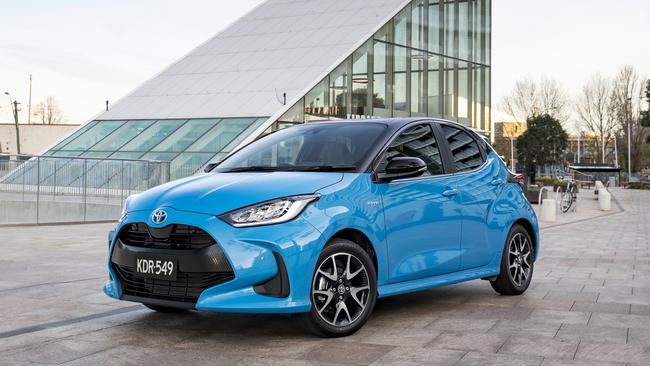2020 Toyota Yaris Hybrid review: Hyper efficient small car gets bug price rise
The Toyota Yaris has always been one of the country’s favourite small cars and it now comes as a hybrid. We find out if it is worth the sky-high price tag.

New cars
Don't miss out on the headlines from New cars. Followed categories will be added to My News.
The new Toyota Yaris is a little car with a big question to answer: Is it worth it?
Completely revised for 2020, the Yaris is a clever little car with a price tag that has sparked debate throughout the automotive industry.
Toyota can’t hide from the fact its smallest hatch costs almost 44 per cent more than the previous model, likely pushing it out of reach to some cost-conscious buyers looking for a new set of wheels. The manufacturer has sold 250,000 examples of the Yaris in Australia, plus another 82,000 Toyota Echo hatchbacks and sedans — many to young and old drivers on a budget.

Priced from about $25,500 drive-away in basic manual form, the Yaris’ value looks particularly questionable when equipped with an optional hybrid engine preferred by Toyota’s Corolla, Camry and RAV4 buyers.
Only available in mid-grade SX or top-level ZR trim with an automatic transmission, the cheapest Yaris Hybrid costs about $33,000 drive-away, which is more than the bigger Corolla Hybrid’s entry point, and within sight of the family-sized Camry.
The hero car in Toyota’s press photography, a blue Yaris ZR Hybrid with contrasting black roof, costs almost $37,000 drive-away. That’s a little more than a five-door Mini Cooper, or about $5000 beyond the ask of a Corolla Hybrid.

But Toyota says Yaris buyers aren’t interested in bigger cars.
It defends the dollar strategy by pointing out the Yaris has more tech than a Corolla — such as a lightweight lithium-ion battery and centre airbags wedged between front occupants.
Every Yaris has a 7-inch touchscreen with Apple CarPlay and Android Auto, which represents a significant step up from the old model. Likewise, auto emergency braking with pedestrian detection, active cruise control, lane keeping assistance and blind-spot monitoring makes it a winner on the safety front.

New looks are attractive to our eyes, as is a driving position that places you low in the car, with a small and sporty steering wheel that responds quickly to input.
There’s loads of room up front, with plenty of hidey-holes and more boot space than the Corolla. But the back seat isn’t great for adults.
Toyota says customers who can’t afford a new Yaris are welcome to consider its used car program. A good wedge of its media presentation for the new Yaris focused on the popularity of its second-hand models, and how used buyers under 25 get a free driving course until the end of November.
The new car makes a case for affordable ownership thanks to efficient engines and capped-price servicing (uncommonly cheap at $975 for 5 years).
The standard engine is a 1.5-litre 3-cylinder unit which uses 4.9L/100km to make 88kW/145Nm peaks in automatic form.

We tested it with a six-speed manual transmission likely to be ignored by the vast majority of buyers, and saw 6L/100km figures.
The hybrid is much more impressive.
Merging a more efficient 1.5-litre, 67kW/120Nm petrol motor with a 59kW/141Nm electric motor and compact lithium-ion battery, the package is officially good for 85kW of combined power, and official fuel economy of just 3.3L/100km.
That makes it the most efficient model in the range — it even uses less fuel than the famously green Prius.
And unlike the vast majority of cars on sale, the Yaris Hybrid can easily beat its claimed fuel figure. Careful inner-city driving returned outstanding 2.5L/100km economy.
Highway driving will double that.

The Yaris is in its element around town, where compact dimensions, a tight turning circle and eager hybrid power make for easy progress.
Expansive outward vision, supportive seats and sound ergonomics help its case. The Toyota rides well around town, but can feel a little sharp over bigger bumps, and it’s not as fun to toss around as the best in class
It is less impressive at highway speeds, where it lacks the surefooted composure and effortless punch of bigger cars such as the automatic Volkswagen Golf, which is $5000 cheaper in base form than the Yaris Hybrid.
Hyundai i30’s N Line is roughly the same price and has more space, a seven-year warranty and almost double the Toyota’s power for the same money.
With that in mind, the Yaris’ hefty price tag is hard to justify.
VERDICT 3.5/5
The new Toyota Yaris Hybrid is a great car — safe, efficient and well-equipped. But the price pitches it against polished and generously-appointed contenders from the next size up.
HIGH-RIDING OR HIGH PERFORMANCE?
Another two Yaris variants are just around the corner. The Yaris Cross serves as a baby SUV in the same vein as Mazda’s CX-3 or the Honda HR-V, bringing increased ride height and butch looks for a price yet to be revealed. Enthusiasts will be more interested in the Yaris GR4, a road-going tribute to Toyota’s World Rally Car program sending about 185kW of power to all four wheels through a manual transmission. As with the regular Yaris, it won’t be cheap. Expect to pay $50,000 or so for the limited-edition machine
TOYOTA YARIS HYBRID VITALS
Price: From $33,000 drive-away
Engine: 1.5-litre 3-cyl hybrid, 85kW (combined)
Warranty/servicing: 5 yrs, u’ltd km/$975 for 5 years
Safety: Not yet tested, 7 airbags, auto emergency braking, active cruise control, lane keeping assistance, blind-spot monitoring, rear cross-traffic alert
Thirst: 3.3L/100km
Cargo: 270 litres
Spare: Temporary
Originally published as 2020 Toyota Yaris Hybrid review: Hyper efficient small car gets bug price rise
